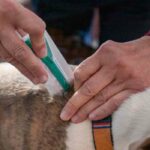
As pet owners, we all want to ensure that our furry friends are healthy and happy. One essential aspect of maintaining your dog’s health is preventing flea infestations. But how often should you give your dog flea treatment? In this section, we’ll explore the ideal frequency for flea prevention and why it’s crucial for your pet’s well-being.
Flea prevention for dogs is essential as these pests can cause a myriad of health problems, including skin irritation, allergies, anemia, and tapeworms. Preventing flea infestations not only keeps your pet healthy but also safeguards your home from an infestation. So, how often should you give your dog flea treatment?
Key Takeaways
- Regular flea prevention is essential to maintain your dog’s health and prevent infestations.
- Flea treatment frequency depends on various factors, including your dog’s lifestyle, the flea season, and your veterinarian’s advice.
- Regular inspection for signs of flea infestation and timely adjustment of flea treatment, if needed, will help keep your dog protected.
Factors to Consider for Flea Treatment Frequency
As a responsible pet owner, I understand the importance of maintaining my dog’s health and preventing flea infestations. When deciding how often to give my dog flea treatment, I consider several factors that can impact the frequency of treatment.
| Factors to Consider | Details |
|---|---|
| Dog’s Lifestyle | The frequency of flea treatment can depend on factors like my dog’s activity level, whether they spend more time indoors or outdoors, and if they interact with other animals that may have fleas. For example, a dog that spends a lot of time outside may require more frequent flea treatment. |
| Flea Season | The flea season in my area can also affect how often I need to give my dog flea treatment. Flea infestations are more common during warmer months, so I might need to increase the frequency of treatment during this time. |
| Flea Prevalence | The prevalence of fleas in my area can impact how often I need to give my dog flea treatment. If there is a high flea population in my local environment, I may need to increase the frequency of treatment to ensure my pet is protected. |
| Veterinarian Recommendations | Finally, I always consider my veterinarian’s recommendations for flea treatment frequency. They can provide professional insight based on factors like my dog’s age, breed, and overall health, as well as any specific risks associated with my local area. |
By considering these factors, I can determine the optimal flea treatment frequency for my dog and help keep them healthy and protected from flea infestations.
Recommended Flea Treatment Frequency
When it comes to flea treatment for dogs, the recommended frequency depends on several factors. For most dogs, monthly flea treatment is recommended to ensure continuous protection against fleas. This is especially important during flea season when the prevalence of fleas is high.
However, quarterly flea treatment may be sufficient for some dogs, especially if they live in areas with low flea prevalence. This is also a more cost-effective option for pet owners.
For specific breeds or dogs that spend a lot of time outdoors, more frequent flea treatment may be necessary. Outdoor dogs are more likely to come into contact with fleas, making them more susceptible to flea infestations. Some breeds, such as those with long hair or a history of flea allergies, may also require more frequent flea treatment to stay protected.
| Type of Dog | Recommended Flea Treatment Frequency |
|---|---|
| Indoor Dog with Low Flea Prevalence | Quarterly |
| Indoor Dog with Moderate to High Flea Prevalence or Outdoor Dog | Monthly |
| Dog with Long Hair or Flea Allergies | Monthly |
It is important to note that these are general guidelines and may vary depending on your dog’s individual needs. Consulting with your veterinarian can provide additional insight into the ideal flea treatment frequency for your pet.
Signs of Flea Infestation and Flea Treatment Adjustment
It is important to be aware of the symptoms of flea infestation in your dog, which may include excessive scratching, redness, or the presence of flea dirt on their fur. If you notice any of these signs, it may be necessary to adjust the frequency of flea treatment. This can involve increasing the frequency of treatments, switching to a different type of flea prevention, or consulting with your veterinarian for professional advice.
In addition to adjusting flea treatment, it is important to engage in continuous flea prevention measures to keep your dog protected. This can include regular inspection for signs of flea infestation, as well as measures such as keeping your dog’s living space clean and using flea-repellent products. By staying vigilant and taking proactive measures, you can help prevent flea infestations and keep your pet healthy and happy.
Conclusion
In conclusion, finding the optimal flea treatment frequency is essential for maintaining your pet’s health and well-being and preventing flea infestations. By considering your dog’s lifestyle, the flea season, and your veterinarian’s advice, you can ensure that your pet is protected from fleas. It is crucial to inspect your dog regularly for signs of flea infestation and adjust the flea treatment if needed.
Remember, if you are unsure about the best flea treatment frequency for your dog, it is always best to consult with a professional. They can provide valuable insight and recommendations based on your pet’s unique needs. Continuous flea prevention, along with regular inspection for fleas, can ensure your dog remains protected and healthy.
Don’t underestimate the importance of flea prevention for your pet’s overall health. By keeping up with flea treatment and taking preventive measures, you can guarantee your dog’s well-being and comfort. So, prioritize your pet’s health and well-being by staying on top of their flea treatment regimen.
FAQ
Q: How often should I give my dog flea treatment?
A: The ideal frequency for giving your dog flea treatment is typically monthly. However, there are certain situations where quarterly treatments may be sufficient. It is important to consider factors such as your dog’s lifestyle, the flea season in your area, the prevalence of fleas, and any recommendations from your veterinarian.
Q: What factors should I consider for flea treatment frequency?
A: When deciding how often to give your dog flea treatment, you should consider factors such as your dog’s lifestyle, the flea season in your area, the prevalence of fleas, and any recommendations from your veterinarian. These factors can help determine the appropriate frequency for flea treatment.
Q: What is the recommended flea treatment frequency?
A: The recommended flea treatment frequency for most dogs is typically monthly. However, certain situations may require quarterly treatments. Additionally, specific breeds or dogs that spend a lot of time outdoors may require more frequent flea treatment. It is best to consult with your veterinarian to determine the most suitable frequency for your dog.
Q: How can I tell if my dog has a flea infestation and adjust flea treatment accordingly?
A: Signs of flea infestation in dogs include excessive scratching, redness, or flea dirt on their fur. If you notice these signs, it may be necessary to adjust the frequency of flea treatment. Continuous flea prevention, along with regular inspection for fleas, is important for keeping your dog protected. If you suspect a flea infestation, it is advisable to consult with a professional for guidance on adjusting flea treatment.
Q: What is the importance of maintaining my dog’s health and preventing flea infestations?
A: Maintaining your dog’s health and preventing flea infestations are essential for their well-being. Fleas can cause discomfort, itching, and even transmit diseases. Finding the optimal flea treatment frequency, considering factors such as your dog’s lifestyle and the advice of your veterinarian, will help ensure your pet’s overall health and prevent infestations. Regular inspection for signs of fleas and timely adjustment of flea treatment, if needed, are crucial for effective flea prevention.
- Does Flea Treatment Kill Lice? - September 8, 2023
- Does Flea Treatment Kill Mites? - September 8, 2023
- How to Put Flea Treatment on a Dog? - September 8, 2023






